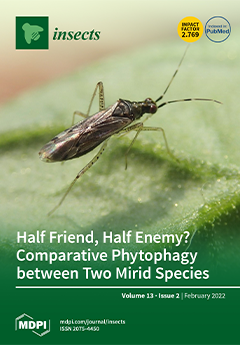We sequenced the complete mitogenomes, 18S and 28S rRNA of two new
Scarites isolates, collected in Eastern Nebraska and Northern Arkansas (US). Based on molecular sequence data comparison and morphological characteristics, the new isolates were identified as a subspecies of
Scarites subterraneus Fabricius
[...] Read more.
We sequenced the complete mitogenomes, 18S and 28S rRNA of two new
Scarites isolates, collected in Eastern Nebraska and Northern Arkansas (US). Based on molecular sequence data comparison and morphological characteristics, the new isolates were identified as a subspecies of
Scarites subterraneus Fabricius 1775, for which we propose the subspecies names ‘
nebraskensis’ and ‘
arkansensis’. The new 18S and 28S rRNA sequences were found to be 99% and 98% identical to
Scarites subterraneus. There are no other
Scarites 18S or 28S rRNA sequences in the Genbank database, however, phylogenetic analysis of the Cox1 genes showed
S. vicinus Chaudoir, 1843, and
S. aterrimus Morawitz, 1863, as the closest relatives. This is the first report of a mitogenome for
S. subterraneus, and only the second mitogenome for that genus. The nucleotide sequence identity between the mitogenomes of the two isolates is 98.8%, while the earlier sequenced
S. buparius Forster 1771 mitogenome is more distantly related, with only 90% (to ssp.
nebraskensis) and 89% (to ssp.
arkansensis) overall nucleotide sequence identity. These new mitogenomes, and their phylogenetic analysis, firmly establish the position of
Scarites on the Carabidae family tree and further refine the genus. In addition to the molecular data provided for the
Scarites species, this approach also allowed us to identify bacterial and viral signatures for
Providencia,
Myroides,
Spiroplasma, and a giant
Nucleocytoviricota virus, associated with the
Scarites species. We hereby present a simple and efficient protocol for identification and phylogenetic analysis of
Scarites, that is applicable to other Coleoptera, based on total DNA extraction and Illumina short-read Next-Gen sequencing.
Full article






